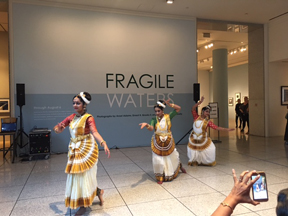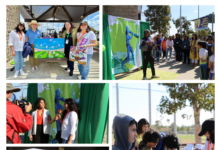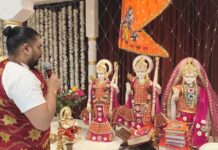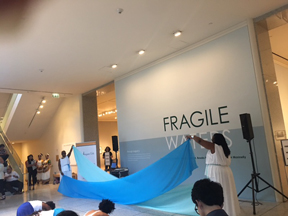
SAN JOSE: Water, water, water everywhere…in a figurative and artistic way was the theme of Liquid Asset, ArtRage exhibit and show at San Jose Museum of Art last weekend. The museum’s exhibit of Ansel Adams’ photography titled “Fragile Waters”, and Diana Al-Hadid’s sculptures titled “Liquid Assets” was complemented with a curated multicultural program on the theme centered on Water.
The evening was a first in a series of continuing partnership between Sangam Arts and the Museum, to be followed by at least two more such programs later in the year. Usha Srinivasan, the director of Sangam Arts has embarked on an initiative called Mosaic America for strengthening multicultural communities through arts and exploring the cultural ties that bind, and this was its maiden venture.
The overlay of the music and
dance compositions to the well-known timeless treasures displayed, added another dimension to the ambience and aura of the evening. The life sustaining water is an integral aspect of our traditions, cultures, folklore and history, and one cannot remain unmoved by its power, vibrancy and potency.
Such were the concepts showcased through classical Indian dance form, Mohiniattam, by Mohini Studios, which, as an art form mimics the landscapes of Kerala, from whence it originates…the swaying hand and body movements, the bewitching
eyes, the gentle undulations of the arms transport you to the land of the sea and palms. In this depiction of “Ganga”, an ode to the River Goddess Ganga, the story is rooted in the descent of the river from the Himalayas, and tamed by the locks of Lord Shiva, lest it inundate the land with its power.
As the Ganga gently flows into the valley, it brings fertility to the soil and prosperity to the people. However, the inconsiderate human wreaks havoc through pollution and overuse of this invaluable resource, imparting the ecological message of conserving and preserving water.
Akoma Arts, an Afro American ensemble paid tribute to Goddess Yamanja, the Mother Goddess of the Ocean in a pulsating, rhythmic, percussion number, evoking tribal overtones, and accentuated by stark body kinesthetics and tribal makeup. The deceptive simplicity of the dance with its blue fabric representing the water and the solid colored costumes drew attention to the fluidity of their dance movements.
The Thingamagigs Performance Group (TPG) used found objects as musical instruments in a non-western improvised performance. A special instrument, dubbed the glass armonica, shaped like a glass bell jar tuned by the level of water contained, produced rhythmic sounds when tapped with fingers or a sponge tipped gong. A flute-like instrument was used next, which produced sounds simulating running water. A third instrument, shaped like a broom and played much like a mouth organ, built up to a crescendo with a very new age, complex feel.
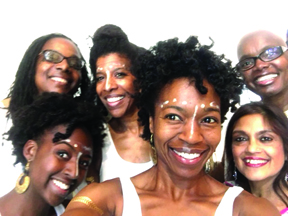 An elaborate system of floating jars on a water filled table turned out to be an electrically stimulated coiled piece with programmed frequencies to cause the discs to move about. Unfortunately, the faint sound produced was not discernible in the open venue with more background sounds than you want.
An elaborate system of floating jars on a water filled table turned out to be an electrically stimulated coiled piece with programmed frequencies to cause the discs to move about. Unfortunately, the faint sound produced was not discernible in the open venue with more background sounds than you want.
For a complete and total immersion in this experience, all one had to do was to close their eyes, and be transported to the land of the cascading Ganga, the legend of the embracing Ocean, or in a rainforest with birds chirping overhead.
Each exhibit was unique and had a story to tell, from the center piece evoking fountains at Roman Piazzas, to melting water dripping from a frozen pebble conglomerate onto strategically arranged sticks to elicit the perfect tonal sounds. We look forward to more such truly unique and intriguing concepts taking shape, thanks to the efforts of Usha Srinivasan, in her relentless pursuit to bridge cultural gaps and unite communities.
Archana Asthana

